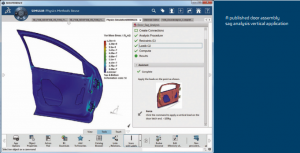We are seeing a change in mindset in industries: They are incorporating simulation earlier in the product development lifecycle. Recognizing this, SIMULIA is fashioning solutions focused on usability, ease and designers’ requirements for design validation.
Industry-specific Vertical Applications created within the 3DEXPERIENCE platform make complex analyses easy for design engineers and help drive their product design. The vertical applications can be set up using the Physics Method Reuse app in a simplified, top-down sequential, user-guided setup ideal for any scenario that has been standardized within an organization. The app comes with any role that includes a scenario app. It is available out-of-the-box with no additional license required, and the XML-based setup requires minimum scripting, facilitating straightforward vertical application construction.
EXAMINING A WORKFLOW ON THE 3DEXPERIENCE PLATFORM
Door hinges play an important role in automobile design. They are part of the door-retention component that holds the door in case of impact. These can become worn or damaged from wear and tear, which causes the door to sag. Door sag causes misalignment, which can prevent the door from shutting correctly and lead to safety issues. Automotive companies have been performing door-sag analyses for a long time now to optimize the door weight and the strength and weight of the hinge components.
The traditional door-sag analysis workflow has been created as a vertical applications on the 3DEXPERIENCE platform. This workflow provides ease of setup and uses our wizard-based vertical application to democratize finite element analysis to engineering designers creating door-hinge components.
This particular analysis was done using the Structural Analysis Engineer role and can be extended to any industry with doors in their assemblies. The car-door model contains the inner and outer sheet-metal panels, which are fastened using spot-welds, and the hinge components, which include the hinge parts and the hinge pin. A load is applied on the door handle side to mimic the weight of a person pushing down on it. Based on the stress results of the analysis, the geometry of the hinges is updated quickly with the power of design parameterization and knowledgeware. The custom vertical application method provides a streamlined way of setting up the simulation model, guiding designers to gain new insights, and offering a timesaving tool for engineers.
With this workflow applied in a vertical application, the design of the door-hinge components is quickly validated with the power of the platform reducing the design cycle time. Furthermore, this contributes to better understanding and collaboration between designers and simulation experts.
Discover all simulation roles for designers and product engineers, here.

